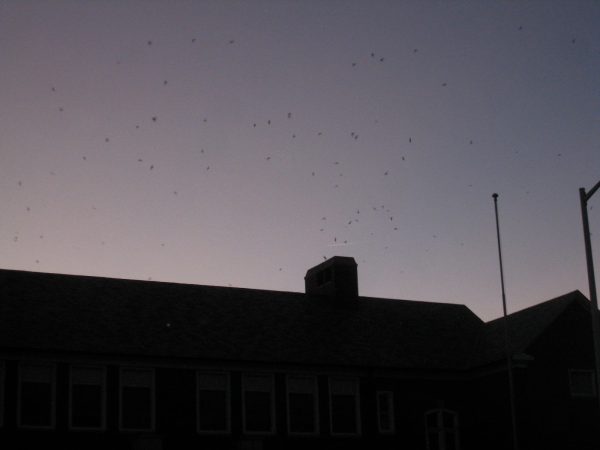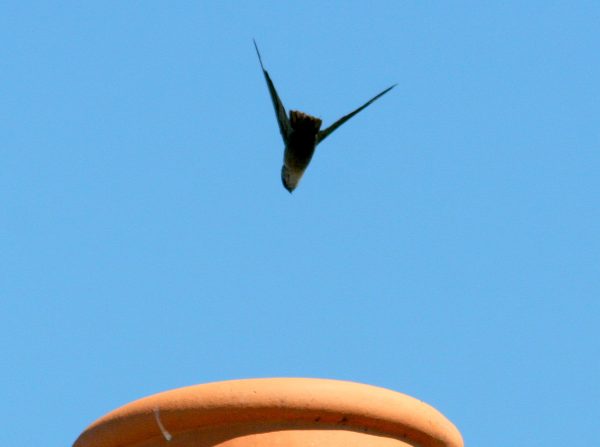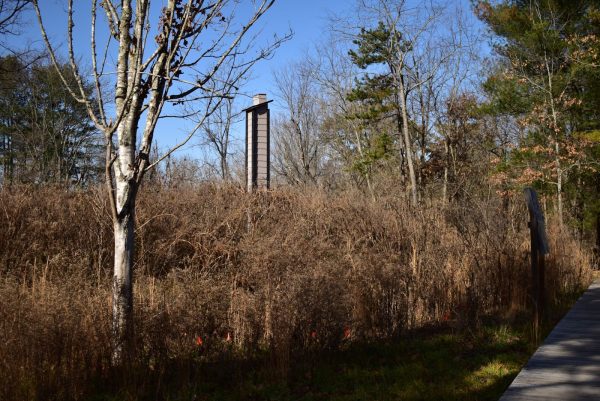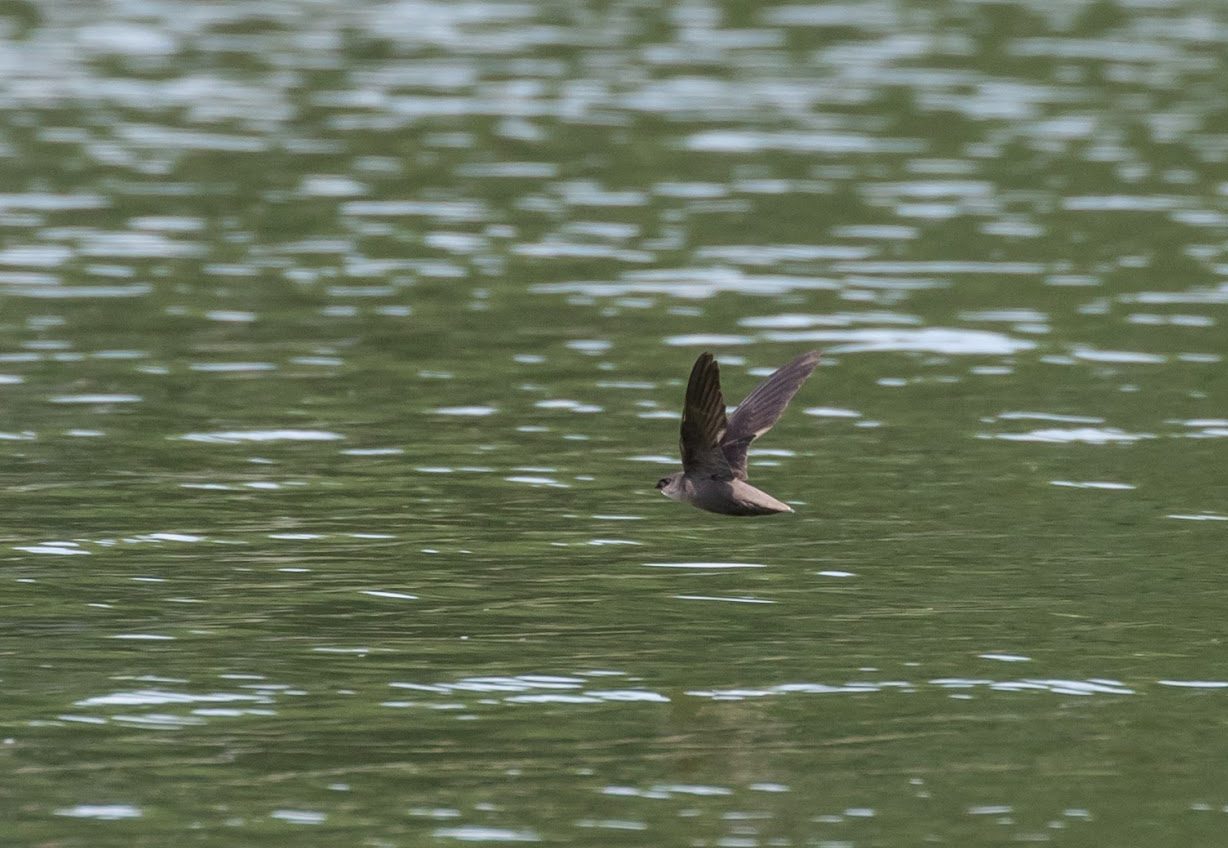A chimney swift darts over a pond in Prospect Park in NYC. Photo by Ryan Mandelbaum.
Introduction
The US Committee of the North American Bird Conservation Initiative (NABCI) published its State of the Birds 2022 report last fall. Among its key findings is a list of birds whose populations have fallen by half between 1970–2019, and are on the trend to lose another 50% of their remaining population in the next 50 years. One of the birds that made this unfortunate list is the chimney swift (Chaetura pelagica).
The story of how chimney swifts found themselves in this declining state is complicated and not entirely understood. But it is a story that is worth exploring because 1. this species is still strong enough to rebound if we act effectively, and 2. their plight draws attention to some larger problems.

To set the stage, here is what you need to know about the life of a chimney swift. They get their name from their propensity to nest in chimneys which act as artificial tree hollows. The swift breeding range spans all across the eastern United States and southeastern Canada. During that breeding time, swift pairs attempt to raise 4 or 5 offspring, with the parents taking turns hunting for insects. Once the hatchlings have fledged, the swifts join larger communal roosts, also often located in chimneys.
As a result of their speed and the height at which they hunt, not much is known with confidence about what species of insects chimney swifts eat, nor is there much confidence about their preferred habitat for hunting. What data is available suggests that they eat a wide range of insects, and make do with a wide range of habitats, including urban ones, so long as they can find nesting and roosting habitat. Come late summer and fall, the chimney swifts amass in the thousands and make their way south across the Gulf of Mexico and Caribbean to the upper Amazon basin of Peru, Ecuador, Chile, and Brazil. Even less is known about their winter life in South America.

So why the decline in numbers?
There are three potential causes for the decline of chimney swift populations:
- Fewer nesting/roosting sites as chimneys fall out of fashion.
- Changes in insect populations.
- Collisions with man-made obstacles.
On top of these three challenges, chimney swifts may find themselves vulnerable to the effects of climate change. In Pennsylvania and the surrounding region, predictions from the Northern Institute of Applied Climate Science suggest that even with mild climate change, we could see more rain in the spring, warmer winters, and hotter summers. Wetter, stormier springtime conditions may ruin more nests than in the past, while hotter summer temperatures can stress and kill the young. More research is needed on this subject, as well as the impact of tropical storms during fall migration – another weather pattern being made more intense by a warming atmosphere.

What can you do to help?
The good news is that we can already take steps to help chimney swifts as more information is gathered about what they need for their recovery. The following are some actions that you could take at home and/or at your places of work:
- If you have a chimney or flue on your house, please don’t cap it and don’t hire someone to remove any swifts that may already nest or roost there. Chimney swifts are not a health threat and you can take steps to reduce any noise disturbance you might experience. Closing off the chimney at the bottom, rather than the top is a better option if you are worried about other animals getting in. If you don’t have a chimney, consider adding an artificial chimney tower. Or perhaps you own a woodlot with some large, standing dead trees. In that case, leave those dead trees standing so that swifts or other wildlife can live in them.
- To address changes in insect populations, there are a couple actions to consider. Converting more lawn and garden space to native plants and removing invasive ones is a broad recommendation that should help to foster the habitats needed by the thousands of insect species that have historically called this region home. Furthermore, reducing light pollution, especially at night, should also help to prevent unnecessary insect deaths. You can do this by switching to LED lights which don’t emit UV light (which is most disruptive to nocturnal creatures) and/or choosing red tinted lights (which even fewer animals can detect), replacing lights with reflective tape wherever possible, and putting lights on timers or motion-sensors.
- Chimney swifts collide with windows, which can often be fatal. Adding window decals helps deter birds from trying to fly “through” the windows. You may be thinking that most window decals are tacky and obstruct views, or maybe that you’ve tried them in the past to mixed success. To that, I would say check out the strategies used at The Discovery Center in Philadelphia, the shared home of Audubon Mid-Atlantic and The Philadelphia Outward Bound School. They use a combination of exterior cords and dot stickers to deter bird collisions while maintaining lovely views of the reservoir and surrounding forest. Audubon recommends placing markings on your windows no more than 2-4 inches apart. By applying dots in a grid that doesn’t leave gaps wide enough for birds to fly through to your windows, you can reduce bird-window impacts with limited impact on your own views and aesthetics.

The impact of climate change
Going beyond these individual actions, we move into the larger issues like climate change. Chimney swifts are not as clearly and directly impacted by climate change as the inhabitants of coral reefs or polar bears. Yet their potential vulnerability combined with the limited amount of time available for studying the problem before we find ourselves and our greenhouse gas emissions beyond a point of return, highlights the need for caution and prevention. We can’t know or plan mitigation efforts for all of the potential impacts of climate change. The worse we make it, the more we will lose. What we can do is acknowledge the threat that climate change poses, and take appropriate political action like demanding large-scale investment in renewable energies, public transit and other energy saving technologies, and forest/soil carbon sequestration projects.
Conclusion
The recommended actions in this article have benefits for more than just chimney swifts. No species exists in a world separate from the rest. Bats use the same types of nesting sites in the warm season. Many bird species have trouble seeing windows and collide fatally, especially during migration times. Migrating birds likewise find artificial lights at night confusing and would benefit from more people reducing their light pollution. Finally, converting lawns and gardens to native plants lays the foundation for the entire food web, from the mycorrhizal fungi in the soil to the birds of prey soaring through the sky. Not every species is as charismatic as chimney swifts, but each has an important role to play in our ecosystems. We, too, are not separate from the ecosystems we shape.
Whether it’s at the small scale of a person feeling joy at seeing swifts dart above their head, or the huge scale of averting the social upheaval of climate chaos, we stand to benefit from these recommended actions. The plight of the chimney swift is our plight too. Do it for them, do it for us, either way, let’s just do it.
Katie Toner, Conservation Easement Steward.
—
Further Reading:
North American Bird Conservation Initiative’s State of the Birds 2022
Aububon’s article on Bird-Friendly Communities: Reducing Bird Collisions with Glass
Cornell Lab of Ornithology’s All About Birds profile on Chimney Swifts
Fun Fact:
Chimney swifts are one of 70-80 species of “true swifts” (the Apodidae family). True swifts are one family in the order Apodiformes whose other families are tree swifts (Hemiprocnidae) and hummingbirds (Trochilidae)! True swift species are distributed across the globe, while tree swift species are only found in Asia and the Pacific Islands, and hummingbirds are only native to the Americas, primarily South America. The earliest known swift fossils are 20 million years old.
